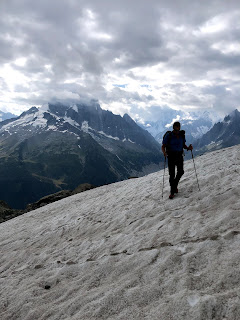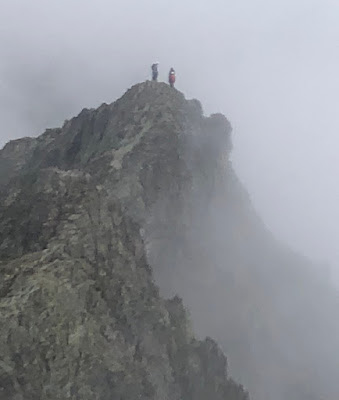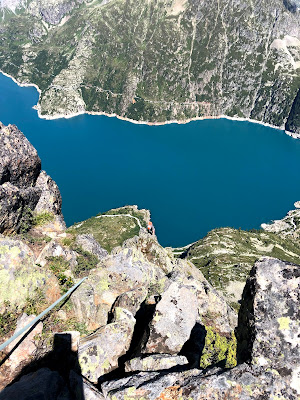 |
A Happy Local Tyrollean.
|
Hopefully in years to come it will be difficult to imagine the complications involved in organising a climbing trip in Covid times. With borders closed , then open then closed it is difficult to plan accordingly.
After much discussion Charles Sherwood and I eventually settled on Italy, a country that for the moment has a grip on the Virus and with no travel restrictions.
I met Charles at Venice airport and we headed for the Tyrol. A part of Italy where everyone speaks German and behaves as if they were Austrian. It is a beautiful and sometimes confusing place to be. We stayed in Val Gardena and used it as a base to climb on the Sella Towers and the surrounding area.
 |
The Sella Towers.
|
We decided to kick off by attempting the traverse of the Sella Towers, ominously described as one of the most popular climbs in the Dolomites. Further it was a Sunday. We reasoned that Covid might make it less popular. In fact what made it unpopular was the weather. We set off in thick mist, yet as we climbed upward we broke through the mist and naturally felt a little smug.
 |
Right place right time.
|
The actual route was challenging to follow. I consulted the guide book for some advice. It gave the most useless description I have ever seen. It said " Just follow the crowds of climbers in front of you."
At the top of the second tower the route off was very difficult to find, no clues no bits of old tat, no pegs, pitons, nothing. There was quite a lot of head scratching until eventually we found the line of rappel points and we scuttled off back to the valley, feeling well exercised. Still it had been good and we had sussed out the line of descent for our attempt on the "Jewel in the Crown " of the Seller Towers the Vinatzer Route on the north face of the third tower.
The next day the forecast was a little "Iffy" so we contented ourselves with some sports climbing just below the sella Pass in the beautiful "City of the Rocks". This is a cluster of crags dotted about in the Larch Trees.
 |
City of the Rocks.
|
The next day we climbed the Vinazter route. We left the car at the col and arrived at the foot of the route at about 9.30am. We were not the first, a German couple were just ahead of us. The face is vast with few distinguishing features low down which gives the whole face an intimidating atmosphere.
 |
Third Sella Tower with the Vinazter route going up the middle of it.
|
After about 5 pitches of steady , but poorly protected climbing we arrived at the Spiral Ledge. Above this is the crux pitch, a finger crack followed by a stout overhang.
 |
Me fighting my way up the crux pitch.[Photo Sherwood]
|
After the crux pitch there is still a considerable amount of climbing and often it is difficult to follow the best line. On one occasion I had a look around a corner to see an unusual sight: Suspended between the top of our tower and the second tower was a slack-line with someone walking across it. Unfortunately I wasn't in a position to take a photo.
 |
Me wondering which way to go.
|
I climbed up a strenuous chimney and all of a sudden found myself at the end of the difficulties. Charles zoomed up to join me .
 |
Charles Sherwood climbing the last pitch.
|
From the summit we could see the slack-line below us, but there was no one walking along it.
 |
The Slack-line stretched between the 2nd&3rd Sella Towers.
|
Like the majority of Dolomitic mountains the descents are often quite complicated. The Third Sella Tower was no exception. It involved lots of short rappels to land us on the Spiral- Ledge. From there we walked down the ledge which is sort of like a giant Helter-Skelter, to then continue a series of rappels which eventually brought us back to the ground.
 |
| Me starting the last of the rappels. |
 |
| Charles making the final rappel. |
The next day we headed to the eastern part of the Dolomites. We weaved our way around the Sella Ronda and stopped at the Cinque Torri for an afternoon of sports climbing. This is an incredible area which is accessible via a chair lift. In fact if you were creating a perfect place to go rock climbing then this would be a good template.
 |
Cinq Torri
|
After the climbing we passed through Cortina and found our selves a simple hotel to stay in on the shores of Lake Misurina.
 |
Tri Cima from Lake Misurina.
|
Our objective for the next day was the uber classic Dulfour route on the west face of the Cima Grande.
We drove up the toll road to the huge car park underneath the south face of the Tri Cima and headed off up the scree towards the start of the climb. Scrambling up scree slopes is never easy yet in under an hour we were near the start of the route.
The line of the route is spectacular, intimidating and on this day soaking wet.
 |
The line of the Dulfour route.
|
We attempted the first two pitches and were caught up by a couple of German climbers. Their enthusiasm was commendable, but this did't change the fact that the route was too wet to climb. We all rappelled off together and retraced our steps back to the car. It was still only mid day and so we used the rest of the day to relocate to a completely different climbing area. We drove to Arco and found a brilliant hotel [Hotel Pace] close to the centre of town.
Arco is wonderful with bars and restaurants, with lots of delicious food. It also seemed to have the highest concentration of climbing shops of anywhere in the world. Chamonix use to have a lot of climbing shops, but has few in comparison to Arco.
We choose to climb a route called Amazzonia 5c as our introduction to the area. The guide book gave it 5 stars. We both felt it was okay , but nothing exceptional and very unusually, it seemed to be under graded.
It was a little too easy.
Anyway it was good to get a sense of what the routes were like and from this we could choose a route a little more testing.
 |
The rock climbing areas around Arco
|
 |
Lago di Toblino seen from the descent path
|
The next day we set ourselves a bit more of a challenge and climbed the very long and sustained "Amici del Sottobosco." 6a. This was a bolted route some 11 pitches long and gave some of the best climbing of the trip.
On our final day we climbed a much shorter, but very good "Follia d'Estate" 6a on Monte Colt just out side the village of Arco and then some single pitch routes in the afternoon where Charles was determined to exhaust himself before returning to the UK.
Finally on our last day We drove along the side of Lake Garda and eventually to Milan airport where I dropped Charles.
I then drove back to Chamonix, where the next day the Italians shut the border between Italy and France.

























































